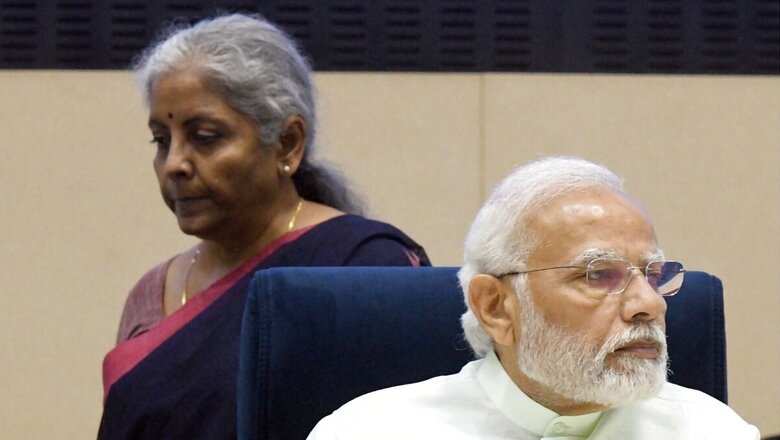
views
The BJP’s national tally too dropped from 303 to 233, prompting people to ask if Nirmala Sitharaman’s budget will be more flexible this time and appease two primary concerns of PM Narendra Modi — the middle class, which isn’t as infatuated with the BJP as it was in 2014, and the two key allies who can smell an opportunity for their home states.
KEEPING THE MIDDLE CLASS HAPPY
It’s expected that Sitharaman’s iPad will have the figures and statistics to woo this segment of society which often complains of being ignored. According to the middle class, apart from the 2019 Union Budget, there hasn’t been any major outreach. So, what can the finance minister bring?
The first big expectation is a change in tax brackets and relief to the salaried class. A higher standard deduction and a possible rejig in tax slabs are two things that will directly benefit the middle class — a segment that has been the core vote bank of the BJP but has slowly started showing the effects of fatigue.
A guaranteed pension under the NPS regime and possible incentives in the much-promoted new tax regime to make it more attractive can’t be ruled out. The boost in housing is also likely to be another measure that Sitharaman may take.
In the Maharashtra budget, the government will provide three free gas cylinders annually to 52.4 lakh households under the newly announced CM Anna Suraksha Yojna. The government also introduced a fee waiver for girls from OBC and EWS families pursuing higher education, which is expected to benefit two lakh girls and has an annual budget of Rs 2,000 crore. The state government announced a housing scheme named after the late Shiv Sena leader Anand Dighe to provide affordable housing to people. It has also decided to increase the health coverage under the Mahatma Jyotiba Phule Jan Arogya Yojana from Rs 1.5 lakh to Rs 5 lakh.
Women have been targeted, much like former Madhya Pradesh chief minister Shivraj Singh Chouhan did in his state. CM Ladki Bahin Yojana, a special scheme for women that will provide Rs 1,500 per month and Rs 46 crore annually, started in July this year. These schemes are particularly meant to woo the middle-class voters of Maharashtra who dealt a heavy blow to the NDA in the recent Lok Sabha election.
If Sitharaman has to take a cue from the populist measures of the government in Maharashtra, she will have the scope to lower the age bracket for the scheme of health benefits for those above 70 years. Soon after coming to power for the third term, the Cabinet decided to further expand the Pradhan Mantri Awas Yojana and construct three crore additional rural and urban houses. Sitharaman will also have the scope of addressing a major area of grouse of the middle class — stopping the 50 per cent concession to female and 40 per cent to male and transgender senior citizen passengers on train fares. It was discontinued during the Covid-19 lockdown but hasn’t been reintroduced ever since.
But all these would mean more expenditure. The GST collection of Rs 2.1 lakh crore in April 2024 may have eased the burden on government coffers, but the regime will have to tread a slippery slope where it keeps the fiscal deficit target reasonable yet makes the middle class happy.
KEEPING THE TDP, JDU HAPPY
It’s not just the middle class that is the government’s concern; they also have the compulsion to keep two of their core allies — TDP and JDU — happy. The Andhra ally’s 16 MPs and Bihar ally’s 12 MPs — who help keep the BJP-led NDA government stable at the Centre — have their own wish lists.
Just before the Union budget, PM Modi granted TDP chief Chandrababu Naidu’s two major wishes — petrochem hub and an oil refinery. Naidu has secured approval for a Rs 60,000 crore refinery in Andhra Pradesh. After his meeting with the prime minister, he met top officials of Bharat Petroleum Corporation Limited. During feasibility talks, three places came up for the refinery — Srikakulam, Machilipatnam and Ramayapatnam. While the location is yet to be finalised and will take more time, the decision is likely to be announced on July 23 during Sitharaman’s Union Budget speech.
That is not all. Another dream project of Naidu has been developing Amaravati city. He has sought central assistance for Amaravati as well as Polavaram from the Union Budget to which there is no confirmation of fulfilment from the government side yet. Naidu wants to build key infrastructure for Amaravati and incremental annual grants to complete the Polavaram project. During the pre-budget consultation, Andhra finance minister Payyavula Keshav sought Rs 15,000 crore for Amaravati alone. Funds sought for Polavaram are over and above that.
While it hasn’t been pressed with urgency, Naidu would also need central assistance for welfare measures on whose promise the NDA government came to power in Andhra Pradesh uprooting Jahan Mohan Reddy. Naidu would also need funds for the Ramayapatnam port, the integrated steel plant in Kadapa, industrial parks, and a new railway zone to name a few. It is still unclear if, and how much, the Modi government would be able to promise in this financial year’s budget.
Another key ally, Nitish Kumar, too is learnt to have made demands of Rs 30,000 crore from this year’s budget for Bihar. This demand was made during pre-budget consultations to Sitharaman in June. Meanwhile, reiterating its old demand, the Janata Dal United (JDU) recently concluded its national executive meeting with a resolution demanding a special status for Bihar.
Mounting political pressure on Kumar, Congress asked the state cabinet to also pass such a resolution and “walk the talk”. This invariably puts pressure on the Centre. While the Modi government had cited the 14th Finance Commission’s report to rule out special category status for any more states, Kumar is ready with substitute demands. He is seeking funds for nine brand-new airports, seven medical colleges, two power projects, and two river water programs.
Now, just the way Nirmala Sitharaman has to tread cautiously between making the middle class happy and respecting fiscal prudence, she will also have to balance the demands of these two key allies and maintain or further go for a bold fiscal deficit target.
In what may make the middle-class hopeful, industry body CII too has favoured a tax relief for income up to Rs 20 lakh in the upcoming budget, expecting it to boost fledgling demand.
What’s sure is that this budget won’t be a typical BJP budget. What’s unsure, however, is how far it will stray towards populism.



















Comments
0 comment